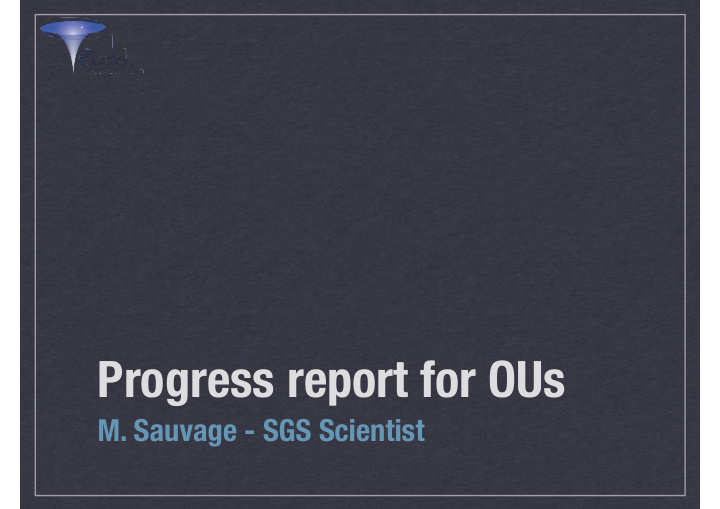



Progress report for OUs M. Sauvage - SGS Scientist
Organization units with significant FR participation This is taken from the CNES CCTP (Cahier des Clauses Techniques Particulières) “some” FR leadership NIR is the only OU without FR participation. SHE and PHZ have significant FR participation but at lower level than other OUs. In the next hour you will have focussed presentations on SPE, SIR, VIS, LE3, MER and EXT, so this presentation will provide an update on LE1, NIR, SIM, SHE and PHZ
General progress report To be fair, half of last year’s work was dedicated to the SRR (preparation, execution, and fallout). OU work restarted in earnest in summer 2016. Focussed on: Assessing situation post SRR (e.g. regarding requirements, OU organization). Making prototype choices. Starting/Resuming development process toward consolidated maturity gates. Preparation and execution of Science Challenges #1 and #2 involving SIM, VIS, NIR and SIR. There have been quite a number of meetings involving the OUs beyond those organized by the PO (Organization Group/Garage Days/System Team). WL-SWG/OU-SHE/OU-LE3 in London OU-PHZ in Geneva
LE1 - Level 1 LE1 is an orphan processing function (no OU, absorbed partially in VIS and NIR). This is the only PF that is meant to run at only one place: the SOC facilities. LE1 activities in France consist in: Development of the VIS functionalities, which appears as a sub-task of the VIS OU (in connection with the VIS IDT). Overseeing and coordination at the PO level (SGS Scientist) to keep the players in synch: VIS OU NIR OU SOC MOC Noteworthy activity: global teleconference with all actors in October. Discussion on on-board communications protocols and impact on data file contents.
NIR - Near infrared images processing NIR is essentially non-French… NIR has changed leadership this year (from A. Grazian to J.L. Polenta) to reflect the contribution of ASI. NIR is also where the US participation to the SGS is most visible (with PHZ), and there are discussions to increase this participation slightly (in the initial calibration steps of the PF). NIR has already started the development of parts of its processing function. There are many opportunities to re-use existing codes (with some porting necessary). Discussions on-going regarding the possibility to adopt LSST code for part of the processing. Prototypes of the pipeline should be available to process Science Challenge 2 in 2016.
SIM - Instrument simulations SIM in France (beyond A. Ealet): P . Hudelot (VIS Pixel simulator), E. Jullo (Sci.), N. Fourmanoit, J. Zoubian (NISP Pixel simulator), R. Fahed (External data simulator). Participation to the very complex “True Universe” development (i.e. collecting and simulating elements of the actual universe beside the cosmology, e.g. Stars). The main 2015 activity was the participation to the Science Challenges: Science Challenge 1: implement all three simulators in the Euclid Framework, with the True Universe module and connection to the Mission DataBase. Production of 12 sq. deg. Many issues due not only to code development problems but also to the MDB, hardware limiting features… 6 months delays but close to completion. Will need some Return on Experience for future challenges. Science Challenge 2: in preparation with a more science-oriented output. Overlap between SC1 and SC2 is a problem. Soon to be deployed on SDC-FR (SC1 ran on SDC-SP) Need more scientific guidance to operate choices in case of problems (to be fixed by PO). Elements provided by A. Ealet
SIM - Instrument simulations Upcoming in 2016: Next week: SIM meeting at CPPM on SDC-SIM integration, new True Universe library, Validation and SC2 final preparation Develop bypass simulations for LE3, in particular with respect to Galaxy Clustering, to release large enough catalogs. Interaction with GCSWG end of January. A general point of concern is noted regarding catalog validation (i.e. what should they contain for SGS purposes and is this content relevant scientifically). Elements provided by A. Ealet
SHE - Shape measurements France has responsibility for defining the validation strategy for the SHE processing function. This has seen a significant overhaul in the past year. We are also producing information/data for the PSF physical model work- package. At the interface with OU-SIM VIS Sim WP . Already using PDR description of optical components. A new work-package has been added to OU-SHE to complement its PSF modeling strategy: PSF modeling fully data-driven based on learning algorithms. Will at least allow the validation of the main PSF modeling approach (physics-based), and in all likelihood will be combined with the physics-based approach to reach required accuracy.
PHZ - Photometric Redshift Computation Work-package Breakdown Structure LEAD: CONTRIBUTION: http://wiki.cosmos.esa.int/euclid/index.php/EC_SGS_OU_PHZ Elements provided by R. Pello
2015 on-going work WP PHZ-3-205 (Template Fitting algorithms). On going work can be monitored on the PHZ wiki: http://wiki.cosmos.esa.int/euclid/index.php/WP4-3-09-3205 PHOSPHOROS = final Euclid algorithm based on « Template Fitting » : Developped at SDC-CH Based on functionalities from existing SED-fitting codes (New-Hyperz, LePhare, … ) A first version is being tested OU-PHZ (hands-on workshop in Dec. 15). Current developments : Improve prescriptions for the IGM Include in a self-consistent way nebular emission (emission lines) Improve prescription for extinction Include priors Participation to the "Data Challenges". DC2 running now( deadline 15 JAN15), tying OU-MER and OU-PHZ. Integrating OU-EXT so that the available DES data is included in this challenge. Elements provided by R. Pello
Upcoming meetings See next presentations for OU-specific meetings 10-12 February: Groningen Garage Days (OUs-SWGs) Organization group (SGS) System Team meeting (SDC)
Recommend
More recommend